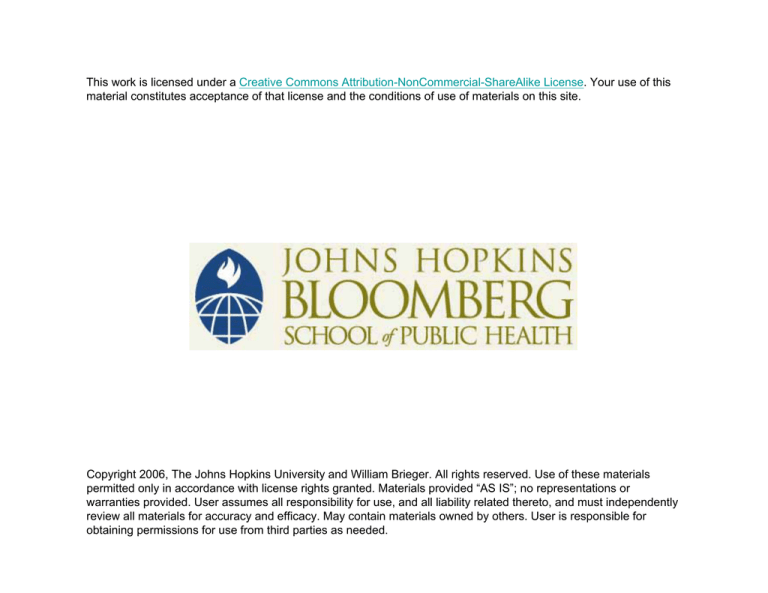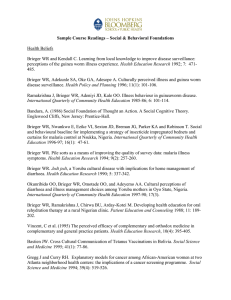
This work is licensed under a Creative Commons Attribution-NonCommercial-ShareAlike License. Your use of this
material constitutes acceptance of that license and the conditions of use of materials on this site.
Copyright 2006, The Johns Hopkins University and William Brieger. All rights reserved. Use of these materials
permitted only in accordance with license rights granted. Materials provided “AS IS”; no representations or
warranties provided. User assumes all responsibility for use, and all liability related thereto, and must independently
review all materials for accuracy and efficacy. May contain materials owned by others. User is responsible for
obtaining permissions for use from third parties as needed.
Social Support
William R. Brieger, MPH, CHES, DrPH
Johns Hopkins University
1
Section A
Definitions and Theories
2
Social Support
Ù “Social support is a feedback provided
via contact with similar and valued
peers” —Gottlieb, 1985
Ù Emotional: Affect, esteem, concern
Ù Instrumental: Aid in labor, money, time
Ù Informational: Suggestions, advice,
information
Ù Appraisal: Feedback, affirmation
Continued
3
Social Support
Ù Support systems “help the individual
mobilize his psychological resources
and master his psychological,
emotional burdens; they share his
tasks; and they supply him with extra
supplies of money, materials, tools,
skills, and cognitive guidance to
improve his handling of his situation.”
— Caplan, 1974
Continued
4
Social Support
Ù Social support: “Feedback from a
primary group that is health protective,
during times of stress”
— Cassel, 1976
5
Links Between Behavior Models
and Social Network Theory
Ù Health belief model
– Cues to action: Other people
provide information,
encouragement to undertake, or
refrain from recommended actions
– Modifying factors: Membership in
social groups provides context for
beliefs and perceptions
Continued
6
Links Between Behavior Models
and Social Network Theory
Ù Social learning theory
– The (social) environment: The
social environment is the context in
which people observe new
behavior and evaluate the
implications directly or vicariously
of new behavior
Continued
7
Links Between Behavior Models
and Social Network Theory
Ù Ecological model
– Interpersonal level: Group
membership provides a context in
which behavior can be encouraged
or discouraged and a means for
interpreting acceptable behavior
8
More Links
Ù PRECEDE
– Reinforcing factors:
Attitudes/behaviors of significant
others that encourage or dissuade
action
Continued
9
More Links
Ù Theory of reasoned action
– External factors: Attitudes toward
reference groups
– Subjective perceptions of norms:
This component is especially
relevant to appraisal and feedback
types of social support
Continued
10
More Links
Ù Diffusion theory
– Characteristics of change agent:
Homophilous communication within
primary groups and channels of
communication—that is, better
communication and information
flow within groups that share
common characteristics
11
Social Support Mediates Between
Individual and Environment
Support Score
Social Support and ANC Registration
in Moniya, Nigeria
25
20
15
19.7
21.3
21.5
3rd
2nd
1st
15.8
10
5
0
Not Reg
Trimester
12
A Social Network
Ù “A specific set of linkages among a
defined set of persons, with the
additional property that the
characteristics of these linkages as a
whole can be used to interpret the
social behavior of the persons
involved”
— Mitchell, 1980
13
Section B
Relationships and Structures
14
Relationships and Structures
John Scott
Ù Relational data are central to the
principle concerns of the sociological
tradition, with its emphasis on the
structure of social action
Ù Structures are built through
relationships, and the structural
concerns of sociology can be pursued
through the collection and analysis of
relational data
Continued
15
Relationships and Structures
John Scott
Ù Social network concepts originally
derived from textile metaphors of
social fabric, web, interweaving, and
interlocking
16
Social networks are units of identity
(Wearing Egbe with stripes)
17
Wearing the same cloth at a Yoruba ceremony is
a means of establishing social identity
18
Groups provide support: Emotional, material,
informational, and feedback
19
Networks are often informal, built from daily interactions—
such as working together,
Continued
20
Selling goods
Continued
21
Cooking for ceremonies
Continued
22
Relaxing after a day’s work
23
Providing instrumental support, like helping roof a
house, is a key social network function
Continued
24
And while the men put on the roof,
women prepare a meal for all
25
Members of a social
network provide
emotional support
during difficult times
Continued
26
The household, in its various forms, is a basic social network
27
Married Couples
Need Social Support
Ù Marriages may be arranged or
negotiated so that there is a
commitment between families
Ù Both families try to make the marriage
work and solve problems/conflicts
Ù In arranged marriages, partners know
the importance of compromise
Ù The marriage is seen as a productive
unit
28
A married couple
29
The Household Economy
Ù
Ù
Ù
Ù
Income, accessing external resources
Allocation and expenditure
Decision making and bargaining
Productive activities inside the
household
Ù Individual member health status as a
result of the above processes
30
Formal networks often form around economic interests:
A beauticians’ society at a town celebration
31
Traders from
neighboring villages
form an association
that sets prices and
oversees sales; if one
member is sick,
another can take his
or her crops to market
for sale
32
The yam sellers meet
together to set prices
and review quality;
these groups also get
together for social
occasions, such as
celebrating when one
of their members has
a naming ceremony or
has a child who gets
his “freedom” from
apprenticeship
33
In the sixth century, Mayan astronomers held conferences to
decide about leap year and other professional matters
34












